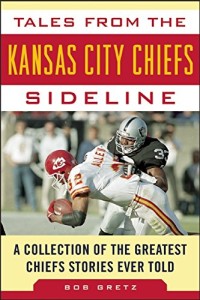Chiefs Digest senior editor Bob Gretz has written Tales from the Kansas City Chiefs Sideline, a collection of the greatest Chiefs stories ever told.
The book covers the story of the Dallas Texans/Chiefs from the first season through the Andy Reid/John Dorsey Era, and is available at all major book stores and through Amazon.com and Barnes & Noble.

Bob Gretz’s latest book, available in stores now.
Here’s an excerpt:
The Mentor Wears Out His Welcome
He was a singular character in the history of the Kansas City Chiefs, maybe in all of pro football. Unique does not begin to accurately describe Hank Stram. When it came to pro football, the mold was not only broken after Stram got into the game, it was shattered into shards so tiny it was impossible for anyone else to create themselves in a similar manner.
Stram was cunning at times, oblivious at other moments. He was a smart man and possessed a great football mind that never really shut down; he was always looking for an edge in dealing with opponents, his own players, officials, fans and those that worked around him. He said the Texans/Chiefs franchise was built on a foundation of “offense and defense camouflage and variety are what we’ve sold since the beginning of our football team.”
As the coach explained in the 1974 book, Great Teams Great Years—Kansas City Chiefs, there was nothing quite as exciting as surprising an opponent with a new scheme that would leave them confused.
“This is the real excitement of professional football,” Stram said. “The game plan, the camouflage and other things that go on trying to win a game hold great appeal.”
Whether on the practice field or at the stadium during a game, Stram strutted around like a bantam rooster in the barnyard, the cock of the walk. In the world of pro football in the 1960s and 1970s he was considered the best-dressed coach in the game. He was always wearing tailored jackets and pants, frequently with his bright red vest. As he lost his hair, he began wearing hairpieces that grew considerably over the course of several years.
As he worked the sidelines during games and the practice field, meetings rooms and film sessions during the week of preparation, Stram often spoke in his own language. His assistant coaches were known as rats. Youngsters around him, whether secretaries or rookies on the roster, were addressed as punks. People that he was not happy with and always the media were called hump heads. When he was scheduling speaking engagements or appearances around the country, Stram always wanted to know where’s the smush boys, the smush which could mean anything from payment in dollars or merchandise. On offense he wanted his team to keep matriculatin’ the ball down the field. He called the coaching department secretaries the Sorry Sisters and he had nicknames for everyone, including the team’s general manager Jack Steadman (The Boy Scout) and his assistant Jim Schaaf (Shaky). When he wanted to know what the gossip was around the NFL he asked for the bird seed.
Part of his chatter was always repeating the final words of his statements: got to get a touchdown here boys, a touchdown here. Boys and lads were thrown into almost every statement made to the players; at times the Polish kid from Gary, Indiana, sounded like a son of the old sod of Ireland.
Stram dubbed himself “The Mentor” and the rest of the world discovered that several months after the Chiefs victory over Minnesota in Super Bowl IV. That’s when the NFL Films highlight production from the championship game debuted. Stram agreed to wear a microphone during the game. It opened up a window to what happens on the field that football fans had never seen.
“We’re catchin’em moving. We’re catchin’em moving a little bit. They’re not ready for the quick count . . . look at’em running around. They don’t know where to go … (Karl) Kassulke was running around there like it was a Chinese fire drill.”
Many in the NFL were turned off by Stram’s chatter, especially in Minnesota where head coach Bud Grant made sure he previewed the Super Bowl film for his players in the days before the Chiefs and Vikings played in the first week of the 1970 regular season. There was no chortling coach that day, as the Vikings beat the Chiefs 27–10. Stram’s offense scored just one touchdown and totaled 218 offensive yards, while turning the ball over four times to Minnesota.
The grumbling about Stram was not limited to peers in the coaching profession. Folks around Kansas City were growing increasingly unhappy with some of the coach’s methods and his personality. But the truth of coaching is personality does not matter. What keeps coaches employed is winning. As the Chiefs moved into a new era with the opening of Arrowhead Stadium and the trickle of Super Bowl veterans leaving the team, winning was down considerably in Kansas City.
And the finger of blame was pointed at Stram. He was the team’s head coach and in effect also the Chiefs football general manager. Steadman held that title, however Stram made all the football decisions, everything from who played, who was traded and drafted, and in his last few seasons how much they were paid. He picked the players, his coaching staff, and the scouts. He was the football leader of the franchise.
“Once a coach is given the opportunity, it’s equally important that he is given supreme authority,” Stram said. “Someone has to have that in any organization. Unless someone does, a lot of problems arise because of divided responsibilities. There’s no way in the world you can survive that.”
The football business had been good for the Chiefs with Stram. Everything changed after the Christmas Day 1971 double-overtime playoff loss to the Miami Dolphins. A few months after that game, Stram signed a new contract for an unheard of 10 seasons. Plus, the coach picked up another title: vice president.
The move of the team out of its training facility in Kansas City’s Swope Park into new offices inside Arrowhead Stadium changed the chemistry of the organization. Even with a palatial office and the long-term deal, Stram admitted he was “disgruntled” with the situation around the team.
“Where once we would have done whatever was necessary to improve the team and its working conditions, that priority had now been forgotten—discarded,” Stram wrote. “People no longer spoke; they sent memos. The bulletin boards groaned under the weight of them.”
Stram directed his ire at Steadman, the team’s general manager. “Jack was a good bookkeeper,” wrote Stram. “However, he was not good with people and he had the ability to say the wrong thing at the wrong time in the wrong way. He didn’t know the first thing about football or players. My understanding with Lamar was I ran the Chiefs and no one would ever interfere with us concerning anything related to the team. This didn’t seem to sit well with Steadman.”
What didn’t sit well with Steadman, Stram or anyone else for that matter was what was going on with the team. They finished 1972 with an 8–6 record and only reached that mark by winning three in a row at the end of the schedule. Oakland won the division with a 10–3–1 record. The Chiefs 1973 season ended with a 7–5–2 record and chased the Raiders again, but went 1–2–1 in the final four games and Oakland won the AFC Western Division crown at 9–4–1.
After three games on the ’74 schedule the Chiefs were 2–1. It would be the last time they owned a winning record that season. They lost five of the next six games and then dropped three of the last five contests on the schedule. The 5–9 record marked the first time since the initial year in Kansas City (1963) that the Chiefs suffered a losing season.
They were just 1–6 playing at Arrowhead that season and crowds that three seasons before pushed past seating capacity disappeared from the stadium. In two home games to finish off the schedule, 60,577 showed up to see the Raiders and there were only 35,480 fans announced in house for the finale against Minnesota.
While the final weeks of the 1974 season were playing out, Steadman was busy behind the scenes. The natives were restless and the general manager was getting an earful every time he went out in public. Steadman gathered a group of civic leaders for a lunch where they were encouraged to speak their minds to Hunt about the situation and specifically Stram.
Slights real and imagined were repeated in front of the owner. Stram was accused of cheating on the golf courses around Kansas City, making extensive use of the “foot” wedge and finding balls near the fairway that on his previous swing were headed out of bounds. Others found fault with Stram.
Hunt was not of the mind to make a change. Stram was his friend, the best man at wedding to Norma. The two fought their way through the start of a team and reached the top of the football mountain. Stram had a hand and influence in everything the Chiefs had done. And, there was that 10-year contract, with seven more years to run. With declining attendance Steadman did not want to see part of the budget eaten over that period of time by paying a head coach he didn’t like. Steadman convinced Hunt the club could get out of the contract and would not have to pay the entire seven seasons.
After the final game of the 1974 season, Stram went to San Francisco to scout the practices at the East-West Shrine Game in Palo Alto. As he ate lunch in a hotel restaurant, he was handed a message to call Hunt. They connected on the phone later that afternoon, with Stram calling from the high school field where the teams were practicing.
He was shocked by what he heard.
“This is a very sad day in the history of the Kansas City Chiefs,” said Stram of Hunt’s words. “I’ve decided to make a coaching change.”
The next day Hunt flew to San Francisco to meet with Stram face-to-face. They got together at the soaring lobby of the Hyatt Hotel at Embarcadero Center. When he arrived, Hunt handed his coach a typed memorandum that explained the change.
“You work for somebody else in a volatile business and that somebody has the authority to do what he wants, whenever he wants,” Stram wrote. “It doesn’t matter what the reason is, because it’s his team, his money, his football. He has the prerogative. I thought Lamar made a wrong decision, but what guy doesn’t when he has just been let go?”
Stram was in his Prairie Village, Kansas, home on December 27 when Hunt told Kansas City of the firing, saying he wanted to “revitalize our organization and give it a fresh approach.”
The now former Chiefs head coach welcomed visitors to his home and took phone calls from the likes of Muhammad Ali, Howard Cosell, and even Mrs. Lamar Hunt. Stram said Norma “was in tears” and told him he would always be the Coach.
After everyone went off to bed and the phone stopped ringing, Stram sat in his den and kept coming back to one thought: “Lamar Hunt was wrong, damn it. He had panicked,” Stram said.
Whether the owner panicked or not, one thing was clear, an era was over.
———-
Bob Gretz is the senior editor for ChiefsDigest.com. Use the contact page to reach him or find him on Twitter: @BobGretzcom.
———-
